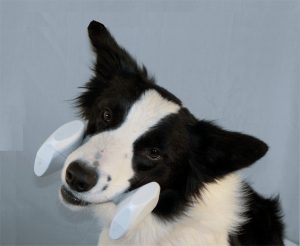Seeking Dog Happiness. My brain was struggling to catch up with my body as I raced from my office. When I got to the kitchen, I acknowledged that I was running toward the sound of a puppy in peril. By the time I entered the laundry room, I had gauged the severity of the screaming. I was going to find a puppy that was dangling, perhaps with its toe caught in the wire gate, ripping flesh off its precious little foot. I hoped it would be only that, although that seemed horrific enough. The shrieking was rhythmic, about a howl per second. I could hear the labored inhale between each cry.
At the far side of the laundry room was my destination. It was four feet wide by eight feet long with two-foot-high plywood sides. The scent of cedar shavings wafted my way. I tripped over a laundry basket and then zigzagged around a dog crate to reach my target. There were seven of them: darling little Border Collie babies in the whelping pen. They had just turned five weeks old. I was hoping that there would still be seven healthy puppies after I addressed the shrieking pup’s trauma.
Seeking Dog Happiness
I inhaled deeply and then exhaled. It felt as if this were the first breath I’d taken since being catapulted from my office. At the far end of the pen was the puppy in question. He was not hanging, caught, or otherwise trapped in any way. Was was not bleeding. He was situated as deeply into the corner as he could manage. His spine was pressed against that plywood box as if he were being sucked into it by an external force. His head was pulled back into his chest. This caused his right front foot to lift slightly off the ground, and it vibrated with each repetitive wail.
Lexie
After an initial assessment, I cocked my head. Then I permitted myself to move my investigation away from the puppy. In the absolute opposite corner of the whelping pen lay his mama. Lexie was a beautiful dog, with perfect Border Collie markings and a kind disposition to match. She was a very special dog and the daughter of my first Border Collie, who had changed the trajectory of my life forever. Lexie had whelped her litter a few weeks earlier. In doing so, she might have donated calcium from her own bones to support the growth of her babies. She had given up her routine, easy life to tend to little animals that depended upon her for nearly every life function. If something had been seriously wrong with that bellowing puppy, she would surely have acted more alarmed.
Instead, Lexie displayed the demeanor of a princess diva. I could almost detect a flick of her head away from that pup, as if to intentionally disregard his drama. She was clearly snubbing the babe. All the while, he was near the point of hyperventilating. His eyes were as big as saucers. His ears were plastered so tightly against his head that he looked like a bald old man. I wondered what might have happened.
Another Puppy
 Just then, I saw another puppy get up and move toward her mother. At five weeks, the puppies could walk, but at times, they still looked a bit drunk. When she was within a few feet of her mama, the pup dropped to her belly. Then, she displayed a very peculiar behavior: she army-crawled closer, slowly and deliberately. Lexie curled her lip nearly imperceptibly—a subtle cue that could easily go unnoticed, especially to an untrained eye. The little puppy slumped to the ground and put her chin down, looking defeated. She crawled just a few inches closer and rested her head on Lexie’s paw. It was obvious that the puppy simply wanted to cuddle with her mother, but Lexie was drawing a line in the sand (or shavings, as the case was). The little female puppy had already learned her lesson. If mama curls her lip, she doesn’t want you to nurse.
Just then, I saw another puppy get up and move toward her mother. At five weeks, the puppies could walk, but at times, they still looked a bit drunk. When she was within a few feet of her mama, the pup dropped to her belly. Then, she displayed a very peculiar behavior: she army-crawled closer, slowly and deliberately. Lexie curled her lip nearly imperceptibly—a subtle cue that could easily go unnoticed, especially to an untrained eye. The little puppy slumped to the ground and put her chin down, looking defeated. She crawled just a few inches closer and rested her head on Lexie’s paw. It was obvious that the puppy simply wanted to cuddle with her mother, but Lexie was drawing a line in the sand (or shavings, as the case was). The little female puppy had already learned her lesson. If mama curls her lip, she doesn’t want you to nurse.
“Dog happiness isn’t measured in treats or toys. It’s found in the trust, consistency, and love we show them each day. At Petworks, we believe every dog deserves a life filled with purpose, comfort, and connection.” – Kevin Kinyon, Co-Founder, Petworks
New Puppies
When puppies are born, they are blind, deaf, and unable to regulate their body temperature. They even need their mother to stimulate them to have bowel movements. They are completely dependent upon their dam. Puppies have one agenda in life at that time: to nurse. They are nipple-seeking missiles. They latch on and don’t let go until they are satiated. Then they fall asleep. When they are very young, their mother is highly dedicated to keeping the puppies close, because they need her warmth. But now it was time for weaning. Imagine how traumatic it must have been for this wee, howling puppy when he discovered that everything he had ever known had been shattered.
One redeeming quality of the weaning process is that it is the most important lesson puppies ever learn. This very simple process is the foundation of canine communication. Weaning is a tutorial for dogs to remain happy and accepted in social groups for the rest of their lives. They will use it to avoid negative consequences and to prevent antisocial dogs from harassing them.
Sadly, the baby puppy that I found bawling in the whelping pen had taken that first lesson quite badly. All puppies are different; they don’t all carry on the way this sniveling one did. Perhaps he was a sensitive sort of guy. Maybe his mother had been a bit heavy-handed in teaching him that nursing was no longer a free-for-all. She would now establish when the puppies could suckle—or, more accurately, when they could not dine. This distinction is critical to understand and assimilate: dogs rarely tell others what to do. Their communication is designed to express what behavior is not acceptable.
Errors Dog Owners Make
At the core of the most common errors dog owners make is the ideology that it is our job to manipulate the dog and to teach him what to do. This goes against all that is canine. Dogs do not dedicate energy to telling other dogs what to do, and they do not inhibit them. They permit other dogs their free will and expect them to exhibit self-restraint. Mama dogs, and other higher-rankings ones are responsible for establishing clear boundaries. The younger dogs then live within those limits or deal with the consequences of noncompliance.

Did you find this article useful? Would you like 100% free access to more articles like these, and free access to over 5,000 vetted pet care service professionals throughout the United States? Sign up here for a free Petworks account, and take 10% off your first booking, on us!
Dog Training
Certainly, teaching dogs to do tasks is part of dog ownership; however, most people do not struggle to train their dogs to do a trick or even get the dog to sit or lie down on a verbal or signal command. What most of my clients struggle with is bad manners—like jumping up, pulling on the leash, barking, whining, and biting. These are behaviors that we want to extinguish. Folks may be able to teach their dogs to sit, but they fail at establishing the standard of staying in place. Remaining in position is really about not getting up. It falls under the category of don’t rather than do. Should be taught in a similar method as teaching a dog not to pull on the leash or to nip at our hands. It can be accomplished in the same way that Lexie taught her baby that she would determine dinnertime, not he. Dog happiness is possible!
If we are going to ask our dogs to integrate into our lives, learn a verbal language, and deal with our crazy human mannerisms, then we owe it to them to use dog-friendly methods when communicating our expectations. This means that we need to shift our strategy from teaching dogs what to do and learn how to communicate what behaviors to avoid.
Dog Happiness
We can forge the finest relationships with our dogs and encourage the best behavior from them by acknowledging and supporting their canine strategy for social conduct. The good thing is that we humans organize our societal rules in the same way that dogs do. Our laws tend to describe negative consequences for unacceptable behavior, too. Using what we know and striving to be benevolent leaders, we can enhance our dogs’ lives. Happy Dog – Happy Human!
About the Author:
 Tammie Rogers graduated with a degree in Biology from Coe College in Cedar Rapids, IA in 1982. Between 1982 – 2002, she was employed as a biologist in academia, a clinical setting, and in corporate America. In 2001, Tammie launched DarnFar Ranch, a full-service dog training company. Between 2002 – 2017 she worked full time as a dog trainer at DarnFar Ranch, a business she operated with her husband, Robert. In 2011, Tammie and Robert founded Committed Canine, a business dedicated to the training of Service Dogs and their handlers. Recently, Tammie’s primary focus has shifted to writing. She continues to work part-time as a dog trainer and business owner while she pursues authoring. Tammie is a professional member of IACP. She is an AKC CGC Evaluator. She has been a Therapy Dog, Inc. Tester/Observer of Therapy Dog teams, and a PetTECH certified Pet First Aid & CPR Instructor. She also served as a herding trial judge for AHBA. She continues to seek pure dog happiness.
Tammie Rogers graduated with a degree in Biology from Coe College in Cedar Rapids, IA in 1982. Between 1982 – 2002, she was employed as a biologist in academia, a clinical setting, and in corporate America. In 2001, Tammie launched DarnFar Ranch, a full-service dog training company. Between 2002 – 2017 she worked full time as a dog trainer at DarnFar Ranch, a business she operated with her husband, Robert. In 2011, Tammie and Robert founded Committed Canine, a business dedicated to the training of Service Dogs and their handlers. Recently, Tammie’s primary focus has shifted to writing. She continues to work part-time as a dog trainer and business owner while she pursues authoring. Tammie is a professional member of IACP. She is an AKC CGC Evaluator. She has been a Therapy Dog, Inc. Tester/Observer of Therapy Dog teams, and a PetTECH certified Pet First Aid & CPR Instructor. She also served as a herding trial judge for AHBA. She continues to seek pure dog happiness.
About Petworks
 In 2021, Dr. Marty Goldstein DVM joined the pet care platform Petworks as an advisor in its Animal Nutrition care division. Dr Marty Nature’s Blend is on a mission to help your pets live their healthiest lives possible. Dr. Marty’s pet nutrition expertise and guidance has helped Petworks evolve and become the preeminent animal and pet nutrition consultation service for pet parents in North America.
In 2021, Dr. Marty Goldstein DVM joined the pet care platform Petworks as an advisor in its Animal Nutrition care division. Dr Marty Nature’s Blend is on a mission to help your pets live their healthiest lives possible. Dr. Marty’s pet nutrition expertise and guidance has helped Petworks evolve and become the preeminent animal and pet nutrition consultation service for pet parents in North America.
 In 2022, Blue Buffalo Founder Bill Bishop Jr. joined Petworks as Senior Advisor in our Animal Nutrition Care Division. Bill brings his extensive expertise in pet food innovation and business leadership. His guidance helps Petworks enhance our pet nutrition service offerings, helping to ensure that pet parents throughout the world receive trusted, science-backed nutritional support for their dogs, cats, and animals.
In 2022, Blue Buffalo Founder Bill Bishop Jr. joined Petworks as Senior Advisor in our Animal Nutrition Care Division. Bill brings his extensive expertise in pet food innovation and business leadership. His guidance helps Petworks enhance our pet nutrition service offerings, helping to ensure that pet parents throughout the world receive trusted, science-backed nutritional support for their dogs, cats, and animals.
 Petworks Co-Founder Kevin Kinyon is a life-long animal lover who works tirelessly to improve the lives of pets and their parents. Human and animal qualities he values most are integrity, humor, and empathy. He is a seeker of dog happiness.
Petworks Co-Founder Kevin Kinyon is a life-long animal lover who works tirelessly to improve the lives of pets and their parents. Human and animal qualities he values most are integrity, humor, and empathy. He is a seeker of dog happiness.


